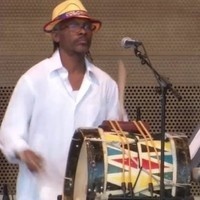
Julio Cesar Montaño Montenegro
It is widely understood that New Orleans is a cultural melting pot, where a variety of musical traditions (Negro spirituals, gospel, folk music, the blues, ragtime, jazz, vaudeville, opera, military marching bands, and more) came together to lay the foundation of American music. What is less well understood is that Puerto Rico has also been a cultural melting pot, where the musical traditions of Taínos, the Spanish, and enslaved Africans came together to form the foundation of the influential Bomba and Plena musical styles.
The roots of Puerto Rico’s folk music run deep. Christopher Columbus landed on the island in 1493, in what was known as Boriken by its indigenous people, Taínos. There were perhaps as many as two million Taíno Amerindians that had already established a rich cultural heritage on the island. While settlements in Puerto Rico go back 4,000 years, Taíno (descendants of Arawak culture) had been dominant on the island since 1000 AD. Evidence of Taíno culture can also be found in Cuba, Haiti, Dominican Republic, Jamaica, and the Bahamas. Taíno cultural traditions were tied closely to their religious rituals. The maraca, a hollowed-out gourd made out of a very thin wood, is a Taino instrument. Other percussion instruments of the Taíno people include a güicharo (guiro), and a mayohuacán. The Taíno were also known to have played a flute made from conch shells.
While the Taíno population was decimated by the Spanish conquistadors, who brought disease and slavery to the island, Taíno culture continued on in the remote mountain regions of central Puerto Rico. The Spanish also took many Taíno women as brides to populate the island. The 2000 census found that 61% of all Puerto Ricans carry Taíno mitochondrial DNA.
Following the decline of the Taíno population, the Spanish brought enslaved Africans to the island beginning in 1513. The music of Bomba is rooted in the political, non-secular, as well as secular expression of African slaves, who primarily came from the Yoruba culture of West Africa. Bomba was played as a celebration of individual and communal life. It was later restricted to Sundays and Feast Days, because it became a catalyst for rebellion.
Bomba drums, called Barriles, were originally made from rum barrels with goatskin heads. It includes the Buleador, which is a lower-pitched instrument that plays a fixed rhythm; a Primo, which is higher pitched, and used to play a varied rhythm; the Taíno Maraca, used to play more complex rhythms, and Cuá or Fuá, a pair of wooden sticks played on the sides of the drum to provide fixed counter rhythms.
The Bomba song structure alters between a solo singer and a chorus in a call and response pattern. After a textural and melodic theme is established, the lead singer improvises, while the chorus sings a fixed response.
Bomba dancing is more improvisational with steps, jumps, shoulder movements and whirls. Dancers dance in competition with others and individually with the lead drummer. Dancers each take leads in challenging the drums with their movements, and the drummer answers by mimicking the dancer with improvisational drumming.
Plena, which was also known as the singing newspaper, is another vital form of Puerto Rican cultural expression which emerged from the intermingling styles of African, Spanish and European cultures around 1900 in the working class coastal city of Ponce. Plena drums are called Panderetas, which originate from the rounded wooden boxes filled with cheese, with box-tops replaced by goatskin. A Plena ensemble includes a hand played frame drum; Seguidora and Segundo drums, which provide fixed rhythms; and Requinto, providing accents and improvising solos; and the Taíno Guiro (scraped gourd). Plena mayalso includes guitar, concertina, tambourine, accordion or harmonica, and singing.
The research in this blog post comes courtesy of Janet Harper, Research Librarian for the Center for Black Music Research (CBMR), who will be part of the program, Exploring Afro-Caribbean Drumming, presented by Jesus Macarena-Avila’s Caribbean Art, Literature, and Music class on Wednesday, October 24, 7 – 9 p.m. in the CBMR, 618 S. Michigan Ave., 6th floor. Co-sponsors include the Columbia Library, the CBMR and Columbia’s Humanities, History and Social Sciences Department. Media sponsors are Contratiempo and Illinois Latino Voice. The event is free and open to the public.
The program, Exploring Afro-Caribbean Drumming, also includes Julio Cesar Montaño Montenegro, who will discuss drumming traditions from Cuba, the Dominican Republic, and Haiti. Montaño Montenegro is the Director of Ecos del Pacifico Afrocolombia, a musical ensemble which focuses on Afro-Colombian music and dance traditions https://www.youtube.com/watch?v=kb6MMQmC9ek. Montenegro was born in Tumaco, Colombia’s Pacific coast. He has an B.A. from Pontificia Bolivariana University and a cultural anthropology degree from the Missionary Institute of Anthropology in Medellin, Colombia. A self-taught visual artist, he explores culture, identity, and territory through his artwork. He has been exhibited in the Chicagoland area at Art in These Times, the Haitian American Museum of Chicago, Metropolitan Café, and Triton College Art Gallery.
